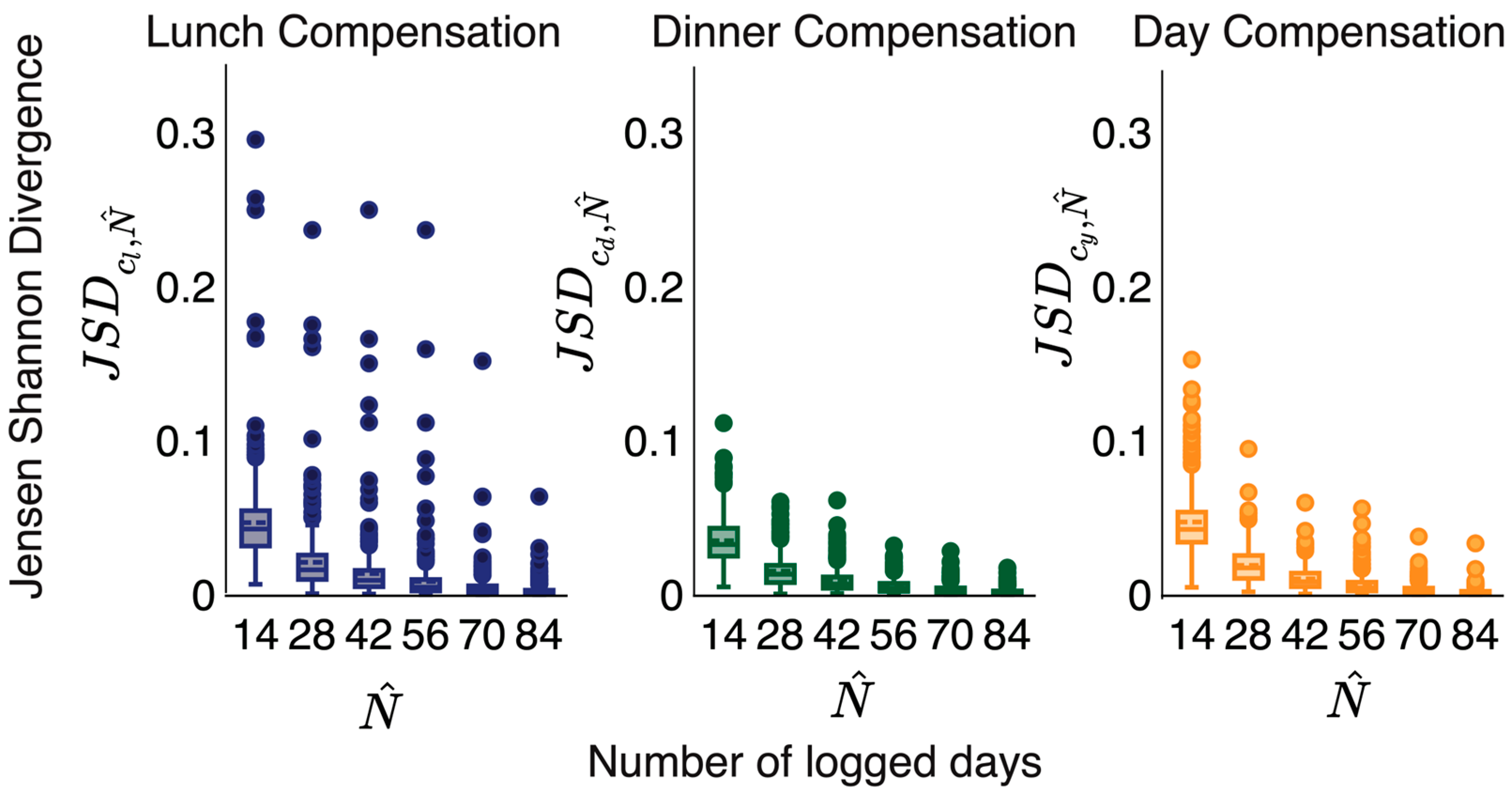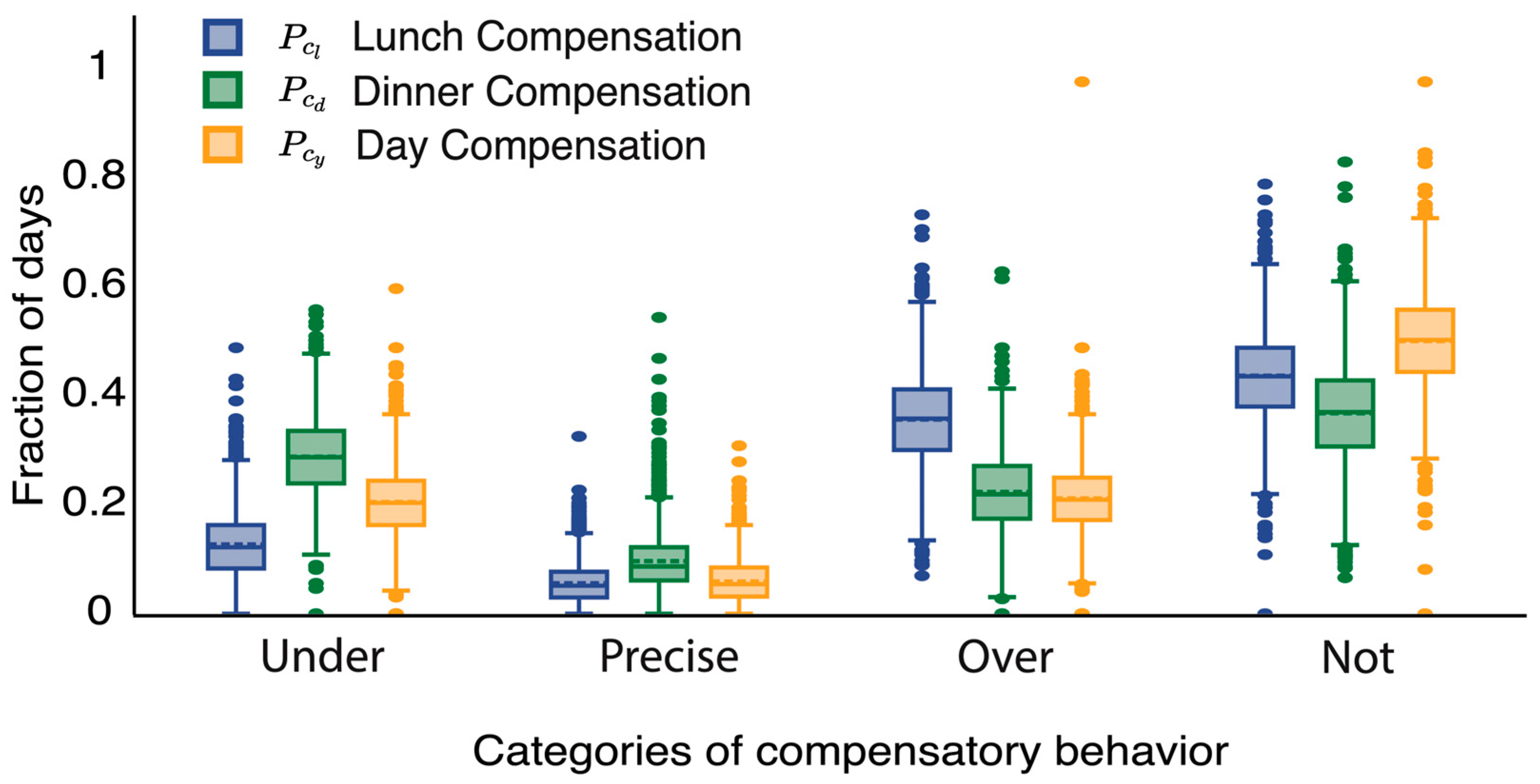Calorie Compensation Patterns Observed in App-Based Food Diaries
Abstract
:1. Introduction
2. Related Work
3. Materials and Method
3.1. Preprocessing MyFitnessPal Food Diary Dataset
3.2. Computational Measure of Compensatory Behavior
3.2.1. Notations
3.2.2. Definitions
3.2.3. Compensation Behavior Measures
4. Analysis Results
4.1. Duration for Measurement of Compensatory Behavior
4.2. Meal and Day Compensation Profiles
4.3. Relation between the Category of Compensatory Behavior and Direction Preload Change
4.4. Relation between the Category of Compensatory Behavior and Adherence to Goal
5. Conclusions
Author Contributions
Funding
Institutional Review Board Statement
Informed Consent Statement
Data Availability Statement
Conflicts of Interest
References
- Bray, G. Obesity increases risk for diabetes. Int. J. Obes. Relat. Metab. Disord. J. Int. Assoc. Study Obes. 1992, 16, S13–S17. [Google Scholar]
- Almiron-Roig, E.; Palla, L.; Guest, K.; Ricchiuti, C.; Vint, N.; Jebb, S.A.; Drewnowski, A. Factors that determine energy compensation: A systematic review of preload studies. Nutr. Rev. 2013, 71, 458–473. [Google Scholar] [CrossRef] [PubMed]
- Kral, T.V.; Allison, D.B.; Birch, L.L.; Stallings, V.A.; Moore, R.H.; Faith, M.S. Caloric compensation and eating in the absence of hunger in 5-to 12-y-old weight-discordant siblings. Am. J. Clin. Nutr. 2012, 96, 574–583. [Google Scholar] [CrossRef]
- Cecil, J.E.; Palmer, C.N.; Wrieden, W.; Murrie, I.; Bolton-Smith, C.; Watt, P.; Wallis, D.J.; Hetherington, M.M. Energy intakes of children after preloads: Adjustment, not compensation. Am. J. Clin. Nutr. 2005, 82, 302–308. [Google Scholar] [CrossRef] [PubMed]
- Appleton, K.M.; Martins, C.; Morgan, L.M. Age and experience predict accurate short-term energy compensation in adults. Appetite 2011, 56, 602–606. [Google Scholar] [CrossRef] [PubMed]
- Zandstra, E.H.; Mathey, M.A.; de Graaf, C.; van Staveren, W.A. Short-term regulation of food intake in children, young adults and the elderly. Eur. J. Clin. Nutr. 2000, 54, 239–246. [Google Scholar] [CrossRef] [PubMed]
- Weber, I.; Achananuparp, P. Insights from machine-learned diet success prediction. In Biocomputing 2016: Proceedings of the Pacific Symposium; World Scientific: Singapore, 2016; pp. 540–551. [Google Scholar]
- Maringer, M.; van’t Veer, P.; Klepacz, N.; Verain, M.C.; Normann, A.; Ekman, S.; Timotijevic, L.; Raats, M.M.; Geelen, A. Userdocumented food consumption data from publicly available apps: An analysis of opportunities and challenges for nutrition research. Nutr. J. 2018, 17, 59. [Google Scholar] [CrossRef]
- Khazen, W.; Jeanne, J.F.; Demaretz, L.; Schäfer, F.; Fagherazzi, G. Rethinking the use of mobile apps for dietary assessment in medical research. J. Med. Internet Res. 2020, 22, e15619. [Google Scholar] [CrossRef]
- McKiernan, F.; Hollis, J.; Mattes, R. Short-term dietary compensation in free-living adults. Physiol. E Behav. 2008, 93, 975–983. [Google Scholar] [CrossRef]
- Achananuparp, P.; Weber, I. Extracting food substitutes from food diary via distributional similarity. arXiv 2016, arXiv:1607.08807. [Google Scholar]
- Liu, Y.; Lee, H.; Achananuparp, P.; Lim, E.P.; Cheng, T.L.; Lin, S.D. Characterizing and predicting repeat food consumption behavior for just-in-time interventions. In Proceedings of the 9th International Conference on Digital Public Health, Marseille, France, 20–23 November 2019; pp. 11–20. [Google Scholar]
- Althoff, T.; Nilforoshan, H.; Hua, J.; Leskovec, J. Large-scale diet tracking data reveal disparate associations between food environment and diet. Nat. Commun. 2022, 13, 267. [Google Scholar] [CrossRef]
- Achananuparp, P.; Lim, E.P.; Abhishek, V. Does journaling encourage healthier choices? Analyzing healthy eating behaviors of food journalers. In Proceedings of the 2018 International Conference on Digital Health, Lyon, France, 23–26 April 2018; pp. 35–44. [Google Scholar]
- Pai, A.; Sabharwal, A. Food Habits: Insights from Food Diaries via Computational Recurrence Measures. Sensors 2022, 22, 2753. [Google Scholar] [CrossRef]
- Akkoyunlu, S.; Manfredotti, C.; Cornuéjols, A.; Darcel, N.; Delaere, F. Exploring eating behaviours modelling for user clustering. In Proceedings of the HealthRecSys@ RecSys 2018 Colocated with ACM Recsys’ 18 (ACM Conference Series on Recommender Systems), Vancouver, BC, Canada, 2–7 October 2018; pp. 46–51. [Google Scholar]
- Tansey, W.; Lowe, E.W., Jr.; Scott, J.G. Diet2Vec: Multi-scale analysis of massive dietary data. arXiv 2016, arXiv:1612.00388. [Google Scholar]
- Cordeiro, F.; Epstein, D.A.; Thomaz, E.; Bales, E.; Jagannathan, A.K.; Abowd, G.D.; Fogarty, J. Barriers and negative nudges: Exploring challenges in food journaling. In Proceedings of the 33rd Annual ACM Conference on Human Factors in Computing Systems, Seoul, Republic of Korea, 18–23 April 2015; pp. 1159–1162. [Google Scholar]
- Fuglede, B.; Topsoe, F. Jensen-Shannon divergence and Hilbert space embedding. In Proceedings of the IEEE International Symposium on Information Theory, ISIT 2004, Chicago, IL, USA, 27 June–2 July 2004; p. 31. [Google Scholar]
- Satopaa, V.; Albrecht, J.; Irwin, D.; Raghavan, B. Finding a “kneedle” in a haystack: Detecting knee points in system behavior. In Proceedings of the 2011 31st IEEE International Conference on Distributed Computing Systems Workshops, Minneapolis, MN, USA, 20–24 June 2011; pp. 166–171. [Google Scholar]
- Friedman, M. A Comparison of Alternative Tests of Significance for the Problem of m Rankings. Ann. Math. Stat. 1940, 11, 86–92. [Google Scholar] [CrossRef]
- Wilcoxon, F. Individual Comparisons by Ranking Methods. Biom. Bull. 1945, 1, 80–83. [Google Scholar] [CrossRef]
- Lovan, P.; George, F.; Coccia, C. Calorie Compensation and Self-Regulation of Food Intake in College Students. J. Nutr. Educ. Behav. 2022, 54, 311–319. [Google Scholar] [CrossRef] [PubMed]
- Varady, K.A.; Hellerstein, M.K. Alternate-day fasting and chronic disease prevention: A review of human and animal trials. Am. J. Clin. Nutr. 2007, 86, 7–13. [Google Scholar] [CrossRef]
- Ruzanska, U.A.; Warschburger, P. Intuitive eating mediates the relationship between self-regulation and BMI-Results from a cross-sectional study in a community sample. Eat. Behav. 2019, 33, 23–29. [Google Scholar] [CrossRef]
- Madden, C.E.; Leong, S.L.; Gray, A.; Horwath, C.C. Eating in response to hunger and satiety signals is related to BMI in a nationwide sample of 1601 mid-age New Zealand women. Public Health Nutr. 2012, 15, 2272–2279. [Google Scholar] [CrossRef]
- Tylka, T.L. Development and psychometric evaluation of a measure of intuitive eating. J. Couns. Psychol. 2006, 53, 226. [Google Scholar] [CrossRef]
- Werle, C.O.; Wansink, B.; Payne, C.R. Just thinking about exercise makes me serve more food. Physical activity and calorie compensation. Appetite 2011, 56, 332–335. [Google Scholar] [PubMed]
- Careau, V.; Halsey, L.G.; Pontzer, H.; Ainslie, P.N.; Andersen, L.F.; Anderson, L.J.; Arab, L.; Baddou, I.; Bedu-Addo, K.; Blaak, E.E.; et al. Energy compensation and adiposity in humans. Curr. Biol. 2021, 31, 4659–4666. [Google Scholar] [CrossRef] [PubMed]
- Weber, I.; Achananuparp, P. MyFitnessPal Food Diary Dataset. 2016. Available online: https://www.kaggle.com/datasets/zvikinozadze/myfitnesspal-dataset (accessed on 13 September 2023). [CrossRef]




| Percentage of Users (%) | ||||||
|---|---|---|---|---|---|---|
| Positive Change in Preload | Negative Change in Preload | |||||
| Lunch | Dinner | Day | Lunch | Dinner | Day | |
| (n = 1149) | (n = 1444) | (n = 1037) | (n = 1047) | (n = 1444) | (n = 1021) | |
| Over | ||||||
| Precise | ||||||
| Under | ||||||
| Not | ||||||
Disclaimer/Publisher’s Note: The statements, opinions and data contained in all publications are solely those of the individual author(s) and contributor(s) and not of MDPI and/or the editor(s). MDPI and/or the editor(s) disclaim responsibility for any injury to people or property resulting from any ideas, methods, instructions or products referred to in the content. |
© 2023 by the authors. Licensee MDPI, Basel, Switzerland. This article is an open access article distributed under the terms and conditions of the Creative Commons Attribution (CC BY) license (https://creativecommons.org/licenses/by/4.0/).
Share and Cite
Pai, A.; Sabharwal, A. Calorie Compensation Patterns Observed in App-Based Food Diaries. Nutrients 2023, 15, 4007. https://doi.org/10.3390/nu15184007
Pai A, Sabharwal A. Calorie Compensation Patterns Observed in App-Based Food Diaries. Nutrients. 2023; 15(18):4007. https://doi.org/10.3390/nu15184007
Chicago/Turabian StylePai, Amruta, and Ashutosh Sabharwal. 2023. "Calorie Compensation Patterns Observed in App-Based Food Diaries" Nutrients 15, no. 18: 4007. https://doi.org/10.3390/nu15184007
APA StylePai, A., & Sabharwal, A. (2023). Calorie Compensation Patterns Observed in App-Based Food Diaries. Nutrients, 15(18), 4007. https://doi.org/10.3390/nu15184007






